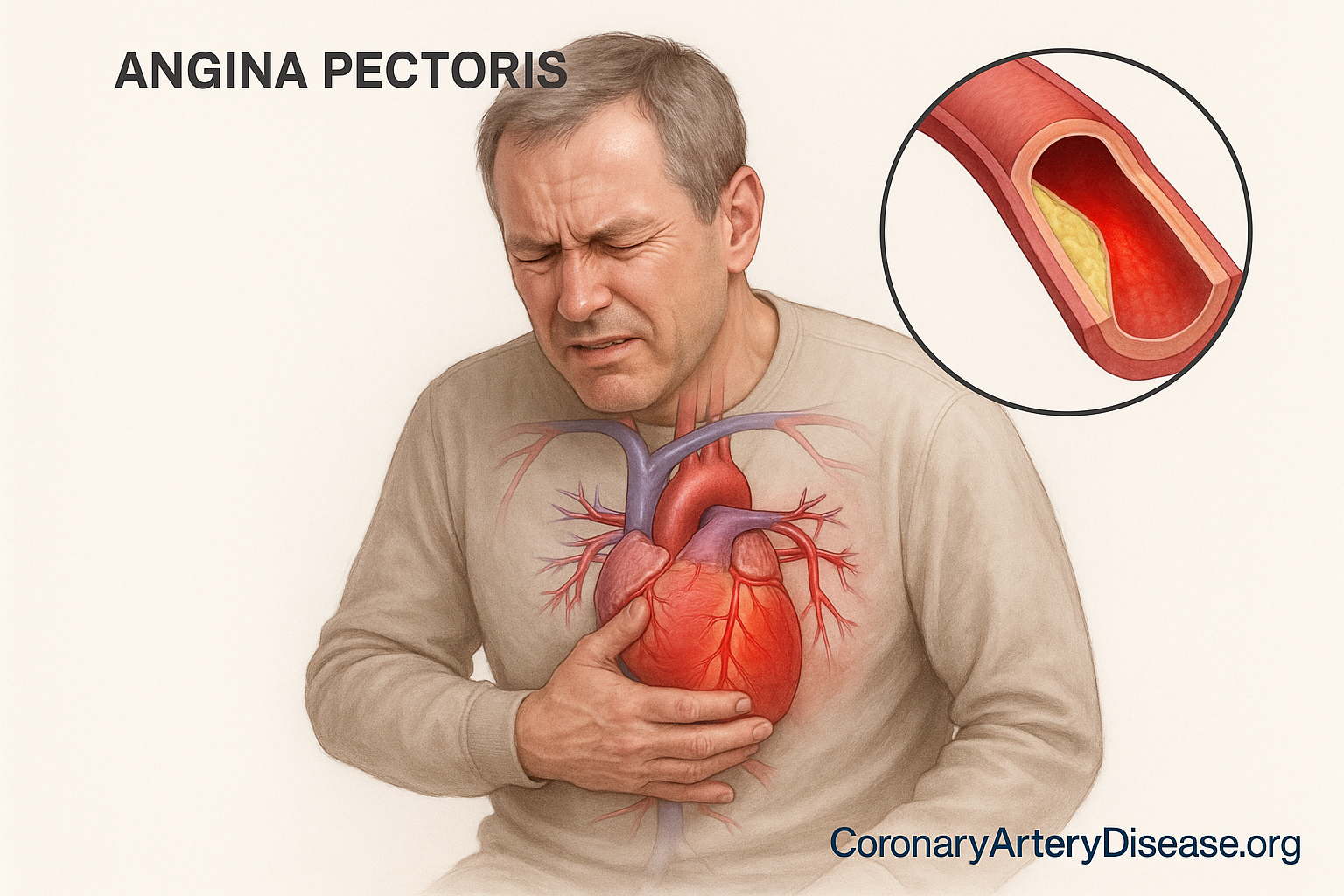Overview
Angina pectoris, often simply called angina, is a common medical condition that causes a feeling of discomfort, typically in the chest. However, this discomfort can also be felt in other areas like the jaw, arm, or even between the shoulder blades or in the upper abdomen. This feeling arises when your heart muscle isn’t getting enough oxygen-rich blood, a condition known as myocardial ischemia (which means a lack of blood flow and oxygen to the heart muscle). It’s essentially your heart sending a signal that it needs more oxygen than it’s currently receiving.
While many people associate angina with “chest pain,” it’s more often described as a sensation of pressure, tightness, or discomfort rather than a sharp pain. It is a frequent symptom of coronary artery disease, where the blood vessels that supply your heart become narrowed, restricting blood flow.
In details
First: Let’s talk about a quick list of key characteristics of angina
- Primary cause:
Most commonly due to coronary atherosclerosis (a build-up of fatty deposits, called plaques, that narrow the heart’s arteries).
- Location of discomfort:
Usually felt in the central chest, but can also be in the jaw, arm (often the left), teeth, or upper abdomen (epigastric)
- Description of sensation:
Often described as heavy, tight, pressure, dull, squeezing, or like a weight on the chest. Some may describe it like indigestion. William Heberden, who first described it in 1772, called it a “painful and most disagreeable sensation.
- Common precipitants:
Typically brought on by physical exertion (like walking, especially after eating), emotional stress, or exposure to cold temperatures.
- Relieving factors:
Usually eases with rest or after taking specific medications like sublingual nitrates (medications placed under the tongue).
- Associated symptoms:
May include sweating, pallor (unusual paleness), nausea, or a feeling of alarm.
The discomfort of angina occurs because a part of your heart muscle isn’t receiving enough oxygen-rich blood, leading to myocardial ischemia. This usually happens when the coronary arteries, which are the vital blood vessels responsible for supplying blood to your heart muscle, have become narrowed or hardened. This narrowing is primarily caused by atherosclerosis, a condition where fatty deposits, build up on the inner walls of these arteries. When you exert yourself or experience stress, your heart demands more oxygen, but the narrowed arteries cannot supply enough blood to meet this demand, leading to ischemia and the characteristic symptoms of angina.
The sensation of discomfort in angina is believed to come from nerve endings located near the endocardium (the inner lining of your heart). These nerve endings are stimulated by certain substances, such as adenosine, lactate, and H+, which are produced when heart cells are deprived of oxygen. These nerve signals then travel predominantly through the sympathetic nervous system to your brain, leading to the perception of discomfort. While the discomfort is often felt in the center of the chest, its exact location can be vague, and the feeling can vary significantly from person to person. For some, angina might manifest atypically, for example, as discomfort felt only between the shoulder blades (interscapular) or in the upper abdomen (epigastric), without any traditional chest discomfort.
It’s important to know that the frequency and severity of angina do not always perfectly indicate how severe the underlying coronary artery atherosclerosis is. Furthermore, some patients with myocardial ischemia might not experience any symptoms at all, a condition known as ‘silent ischemia’. About 40% of all episodes of ST depression (a change seen on an ECG indicating ischemia) are asymptomatic. Silent ischemia is more common in elderly individuals and those with diabetes mellitus. Sometimes, shortness of breath (dyspnea) can be the only symptom experienced during myocardial ischemia, which is referred to as an ‘angina equivalent’.
Other similar questions:
What causes angina?
The most common cause is coronary atherosclerosis. Less common causes include other diseases of the coronary arteries (such as blood clots, spasm, or inflammation), other heart conditions (like a thickened heart muscle or severe aortic valve disease), or conditions where the body has a very high demand for blood, such as severe anemia or an overactive thyroid (thyrotoxicosis).
How is angina diagnosed?
A doctor will evaluate your symptoms, considering your risk factors for coronary artery disease, such as age, male gender, family history, tobacco smoking, diabetes mellitus, and high cholesterol (hyperlipidaemia). They may also use various investigations, an electrocardiogram (ECG), a chest X-ray, or more specialized non-invasive tests or stress echocardiography. A detailed and accurate history from the patient is crucial for diagnosis.
Resources:
Clinical presentation and diagnosis of coronary artery disease: stable angina
S W Davies Department of Cardiology, Royal Brompton Hospital, London, UK


Leave a Reply